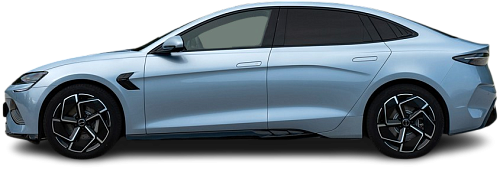Global EV Comparison: BYD Seal Design RWD vs XPENG P7 AWD Performance
Struggling to Decide? Let AI Help!
Your AI Summary Is Ready!
General Info
Both vehicles are currently in production and can be purchased new. The BYD Seal Design RWD (2022-…) has a starting price of €44990, compared to the XPENG P7 AWD Performance (2023-…), which starts at €58600.
The two vehicles share the same body style: Sedan.
| Property | BYD Seal Design RWD | XPENG P7 AWD Performance |
|---|---|---|
| Years of Production | 2022-… | 2023-… |
| Current Status | Produced | Produced |
| Country of Manufacture | China | China |
| Body Style | Sedan | Sedan |
| Market Availability | EU | EU |
| Price Europe (New) | €44990 | €58600 |
| Price Europe (Used) | €38440 | €43870 |
| GCC Score | 6.6 | 6.5 |
Range and Efficiency
Even though the XPENG P7 AWD Performance (2023-…) has a larger battery, the BYD Seal Design RWD (2022-…) higher energy efficiency results in a longer real-world driving range.
| Property | BYD Seal Design RWD | XPENG P7 AWD Performance |
|---|---|---|
| Range (WLTP) | 570 km | 505 km |
| Range (GCC) | 485 km | 429 km |
| Battery Capacity (Nominal) | 84 kWh | 86.2 kWh |
| Battery Capacity (Usable) | 82.5 kWh | 82.7 kWh |
| Efficiency per 100 km | 17 kWh/100 km | 19.3 kWh/100 km |
| Efficiency per kWh | 5.88 km/kWh | 5.19 km/kWh |
| Range and Efficiency Score | 8.3 | 6.8 |
Charging
Both vehicles utilize a standard 400-volt architecture.
The XPENG P7 AWD Performance (2023-…) offers faster charging speeds at DC stations, reaching up to 182 kW, while the BYD Seal Design RWD (2022-…) maxes out at 150 kW.
Both vehicles are equipped with the same on-board charger, supporting a maximum AC charging power of 11 kW.
| Property | BYD Seal Design RWD | XPENG P7 AWD Performance |
|---|---|---|
| Max Charging Power (AC) | 11 kW | 11 kW |
| Max Charging Power (DC) | 150 kW | 182 kW |
| Architecture | 400 V | 400 V |
| Charge Port | CCS Type 2 | CCS Type 2 |
| Charging Score | 6.6 | 6.8 |
Performance
The BYD Seal Design RWD (2022-…) is rear-wheel drive, while the XPENG P7 AWD Performance (2023-…) offers an all-wheel drive system.
The XPENG P7 AWD Performance (2023-…) boasts greater motor power and accelerates faster from 0 to 100 km/h.
| Property | BYD Seal Design RWD | XPENG P7 AWD Performance |
|---|---|---|
| Drive Type | RWD | AWD |
| Motor Type | PMSM | PMSM (front), PMSM (rear) |
| Motor Power (kW) | 230 kW | 348 kW |
| Motor Power (hp) | 308 hp | 467 hp |
| Motor Torque | 360 Nm | 757 Nm |
| 0-100 km/h | 5.9 s | 4.1 s |
| Top Speed | 180 km/h | 200 km/h |
| Performance Score | 4.5 | 6.2 |
Dimensions
The BYD Seal Design RWD (2022-…) and XPENG P7 AWD Performance (2023-…) are about the same size.
The XPENG P7 AWD Performance (2023-…) boasts a more extended wheelbase.
| Property | BYD Seal Design RWD | XPENG P7 AWD Performance |
|---|---|---|
| Length | 4800 mm | 4888 mm |
| Width (with Mirrors) | 2150 mm | - Width (with Mirrors) |
| Width (w/o Mirrors) | 1875 mm | 1896 mm |
| Height | 1460 mm | 1450 mm |
| Wheelbase | 2920 mm | 2998 mm |
Cargo and Towing
A frunk (front trunk) is available in the BYD Seal Design RWD (2022-…), but the XPENG P7 AWD Performance (2023-…) doesn’t have one.
The BYD Seal Design RWD (2022-…) has a towing capacity of up to 750 kg, whereas the XPENG P7 AWD Performance (2023-…) is not officially rated for towing in the EU.
| Property | BYD Seal Design RWD | XPENG P7 AWD Performance |
|---|---|---|
| Number of Seats | 5 | 5 |
| Curb Weight | 2055 kg | 2215 kg |
| Cargo Volume (Trunk) | 400 l | 440 l |
| Cargo Volume (Frunk) | 53 l | - Cargo Volume (Frunk) |
| Towing Capacity | 750 kg | - Towing Capacity |
| Cargo and Towing Score | 5.3 | 4.8 |




